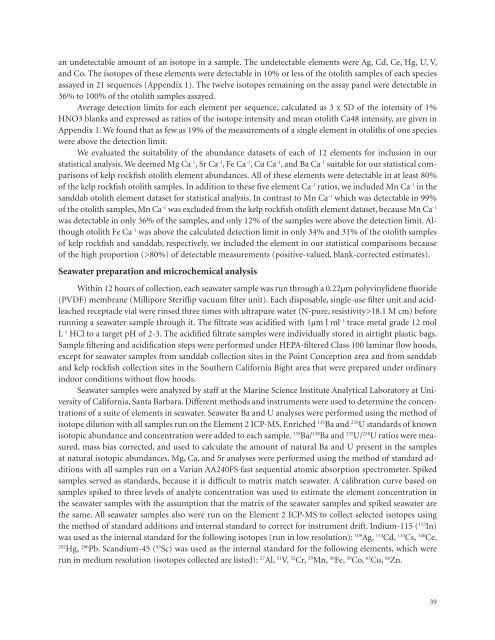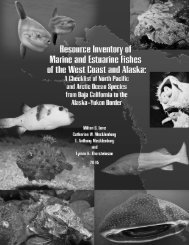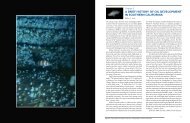Reproductive Ecology and Body Burden of Resident ... - The Love Lab
Reproductive Ecology and Body Burden of Resident ... - The Love Lab
Reproductive Ecology and Body Burden of Resident ... - The Love Lab
Create successful ePaper yourself
Turn your PDF publications into a flip-book with our unique Google optimized e-Paper software.
an undetectable amount <strong>of</strong> an isotope in a sample. <strong>The</strong> undetectable elements were Ag, Cd, Ce, Hg, U, V,<br />
<strong>and</strong> Co. <strong>The</strong> isotopes <strong>of</strong> these elements were detectable in 10% or less <strong>of</strong> the otolith samples <strong>of</strong> each species<br />
assayed in 21 sequences (Appendix 1). <strong>The</strong> twelve isotopes remaining on the assay panel were detectable in<br />
36% to 100% <strong>of</strong> the otolith samples assayed.<br />
Average detection limits for each element per sequence, calculated as 3 x SD <strong>of</strong> the intensity <strong>of</strong> 1%<br />
HNO3 blanks <strong>and</strong> expressed as ratios <strong>of</strong> the isotope intensity <strong>and</strong> mean otolith Ca48 intensity, are given in<br />
Appendix 1. We found that as few as 19% <strong>of</strong> the measurements <strong>of</strong> a single element in otoliths <strong>of</strong> one species<br />
were above the detection limit.<br />
We evaluated the suitability <strong>of</strong> the abundance datasets <strong>of</strong> each <strong>of</strong> 12 elements for inclusion in our<br />
statistical analysis. We deemed Mg Ca -1 , Sr Ca -1 , Fe Ca -1 , Cu Ca -1 , <strong>and</strong> Ba Ca -1 suitable for our statistical comparisons<br />
<strong>of</strong> kelp rockfish otolith element abundances. All <strong>of</strong> these elements were detectable in at least 80%<br />
<strong>of</strong> the kelp rockfish otolith samples. In addition to these five element Ca -1 ratios, we included Mn Ca -1 in the<br />
s<strong>and</strong>dab otolith element dataset for statistical analysis. In contrast to Mn Ca -1 which was detectable in 99%<br />
<strong>of</strong> the otolith samples, Mn Ca -1 was excluded from the kelp rockfish otolith element dataset, because Mn Ca -1<br />
was detectable in only 36% <strong>of</strong> the samples, <strong>and</strong> only 12% <strong>of</strong> the samples were above the detection limit. Although<br />
otolith Fe Ca -1 was above the calculated detection limit in only 34% <strong>and</strong> 31% <strong>of</strong> the otolith samples<br />
<strong>of</strong> kelp rockfish <strong>and</strong> s<strong>and</strong>dab, respectively, we included the element in our statistical comparisons because<br />
<strong>of</strong> the high proportion (>80%) <strong>of</strong> detectable measurements (positive-valued, blank-corrected estimates).<br />
Seawater preparation <strong>and</strong> microchemical analysis<br />
Within 12 hours <strong>of</strong> collection, each seawater sample was run through a 0.22µm polyvinylidene fluoride<br />
(PVDF) membrane (Millipore Steriflip vacuum filter unit). Each disposable, single-use filter unit <strong>and</strong> acidleached<br />
receptacle vial were rinsed three times with ultrapure water (N-pure, resistivity>18.1 M cm) before<br />
running a seawater sample through it. <strong>The</strong> filtrate was acidified with 1µm l ml -1 trace metal grade 12 mol<br />
L -1 HCl to a target pH <strong>of</strong> 2-3. <strong>The</strong> acidified filtrate samples were individually stored in airtight plastic bags.<br />
Sample filtering <strong>and</strong> acidification steps were performed under HEPA-filtered Class 100 laminar flow hoods,<br />
except for seawater samples from s<strong>and</strong>dab collection sites in the Point Conception area <strong>and</strong> from s<strong>and</strong>dab<br />
<strong>and</strong> kelp rockfish collection sites in the Southern California Bight area that were prepared under ordinary<br />
indoor conditions without flow hoods.<br />
Seawater samples were analyzed by staff at the Marine Science Institute Analytical <strong>Lab</strong>oratory at University<br />
<strong>of</strong> California, Santa Barbara. Different methods <strong>and</strong> instruments were used to determine the concentrations<br />
<strong>of</strong> a suite <strong>of</strong> elements in seawater. Seawater Ba <strong>and</strong> U analyses were performed using the method <strong>of</strong><br />
isotope dilution with all samples run on the Element 2 ICP-MS. Enriched 135 Ba <strong>and</strong> 235 U st<strong>and</strong>ards <strong>of</strong> known<br />
isotopic abundance <strong>and</strong> concentration were added to each sample. 135 Ba/ 138 Ba <strong>and</strong> 235 U/ 238 U ratios were measured,<br />
mass bias corrected, <strong>and</strong> used to calculate the amount <strong>of</strong> natural Ba <strong>and</strong> U present in the samples<br />
at natural isotopic abundances. Mg, Ca, <strong>and</strong> Sr analyses were performed using the method <strong>of</strong> st<strong>and</strong>ard additions<br />
with all samples run on a Varian AA240FS fast sequential atomic absorption spectrometer. Spiked<br />
samples served as st<strong>and</strong>ards, because it is difficult to matrix match seawater. A calibration curve based on<br />
samples spiked to three levels <strong>of</strong> analyte concentration was used to estimate the element concentration in<br />
the seawater samples with the assumption that the matrix <strong>of</strong> the seawater samples <strong>and</strong> spiked seawater are<br />
the same. All seawater samples also were run on the Element 2 ICP-MS to collect selected isotopes using<br />
the method <strong>of</strong> st<strong>and</strong>ard additions <strong>and</strong> internal st<strong>and</strong>ard to correct for instrument drift. Indium-115 ( 115 In)<br />
was used as the internal st<strong>and</strong>ard for the following isotopes (run in low resolution): 109 Ag, 114 Cd, 133 Cs, 140 Ce,<br />
202<br />
Hg, 206 Pb. Sc<strong>and</strong>ium-45 ( 45 Sc) was used as the internal st<strong>and</strong>ard for the following elements, which were<br />
run in medium resolution (isotopes collected are listed): 27 Al, 51 V, 52 Cr, 55 Mn, 56 Fe, 59 Co, 63 Cu, 66 Zn.<br />
39




